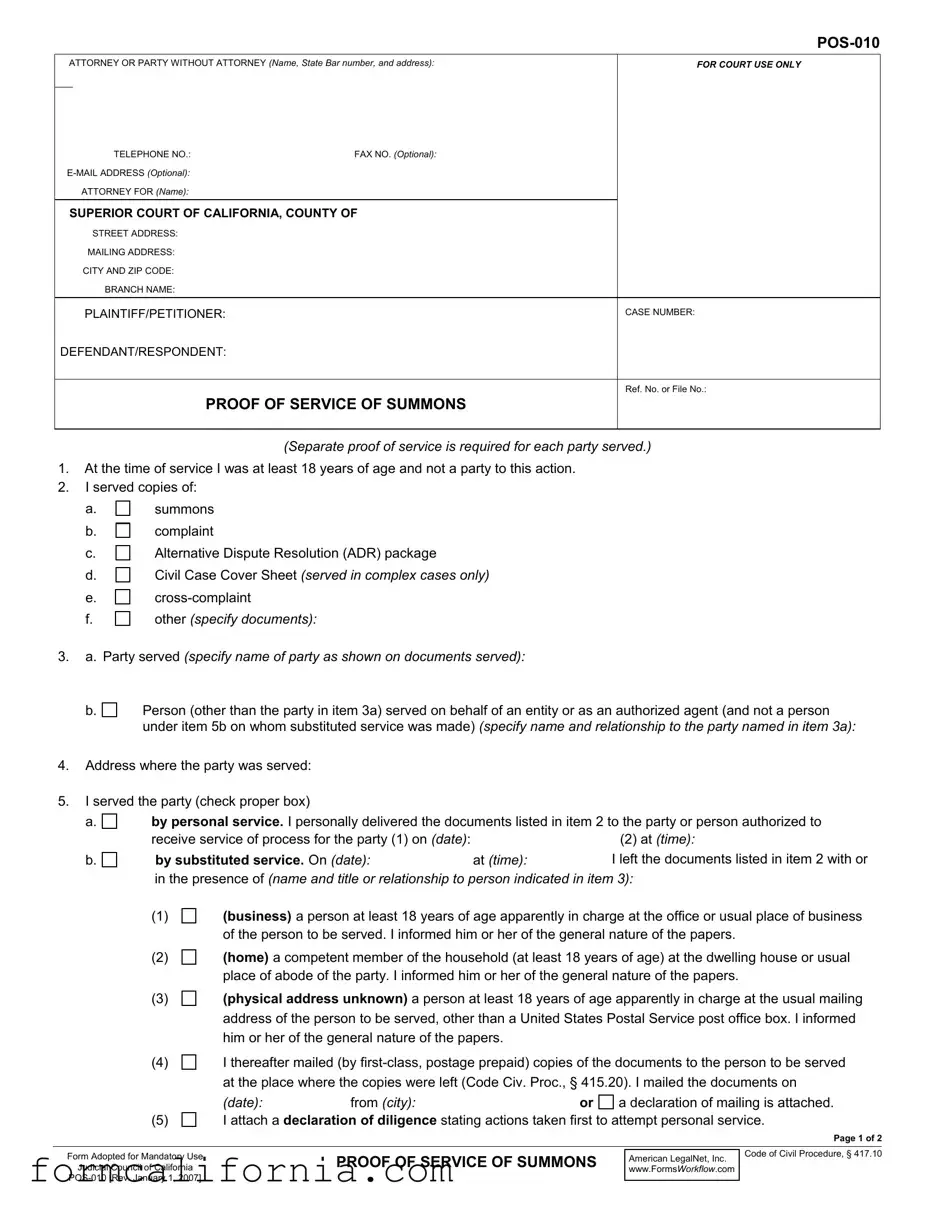The POS-010 form, known as "Proof of Service of Summons," is a documentary cornerstone in California's civil litigation process, akin in its function and necessity to other legal documents within the judicial system. One such document is the "Proof of Service by Mail," which similarly serves as evidence that legal documents have been delivered to the relevant party, but specifically through postal mail. Both documents are crucial in ensuring that all parties are appropriately notified of legal actions, though the methods of delivery and the specifics of the documentation vary.
Another related document is the "Civil Case Cover Sheet," a form that accompanies the filing of a lawsuit in California courts. While it functions more as an introductory document outlining the basics of the case for the court's administrative purposes, it shares the theme of formalizing the initiation of legal proceedings with the POS-010 form. Both are integral in the early stages of a lawsuit, fulfilling the court's requirements for processing and moving the case forward.
The "Summons" itself is intrinsically linked to the Proof of Service of Summons. The summons, which notifies the defendant of the legal action and compels their response, must be served alongside the complaint, and proof of this service (via the POS-010 form) is then submitted to the court. This relationship underscores the summons and POS-010 form as complementary parts of the same legal process of initiating court proceedings.
Similar to the POS-010 but used in familial situations is the "Proof of Service of Summons (Family Law)," which is specific to cases involving divorce, custody, and other family law matters. Although intended for a different court division, both forms fulfill the same pivotal role: verifying that the summoned party has been officially notified of pending legal actions against them.
The "Notice and Acknowledgment of Receipt" is another document that pairs with the Proof of Service, especially when service is done by mail. This form is completed by the recipient to acknowledge the receipt of the legal documents sent, complementing the POS-010 by offering an alternative proof of service method. Both documents together facilitate a smoother and more accountable process of legal notification.
The "Subpoena" form, while used for commandeering a person's presence in court or the production of documents, similarly requires a proof of service to verify its delivery to the relevant individual. This parallel underscores the universal legal principle of ensuring all parties are properly informed of judicial demands or actions concerning them, albeit for varying purposes.
"Request for Entry of Default," a document filed when a defendant fails to respond to a lawsuit within the required timeframe, often follows the process established by the POS-010. The service of summons, proven by the POS-010, is a prerequisite before one can seek a default judgment, tying the effectiveness of the latter to the successful execution of the former.
The "Declaration of Diligence," used when initial attempts at personal service fail, provides detailed attempts made by a server, supporting the efforts outlined in a POS-010 form. It ensures that the court acknowledges multiple attempts at service, cementing the connection between due process and the right to notification.
For serving documents beyond the initiation of a lawsuit, the "Proof of Service" form used in other contexts (not limited to the delivery of a summons) shares its core function with the POS-010. This form captures evidence that any legal document was served, emphasizing the transparency and accountability of legal processes.
Lastly, the "Case Management Statement," which parties file to update the court on a case’s status, may also require a proof of service, although it serves a different phase of litigation. Similar to the POS-010, this underscores the ongoing obligation to keep all parties and the court informed throughout the legal proceedings.
Each of these documents, while serving unique purposes within California's legal framework, connects to the POS-010 form through the underlying principles of due process, notification, and documentation, reflecting the intricate weave of procedures that underpin the pursuit of justice.



 summons
summons
 complaint
complaint
 a declaration of mailing is attached. I attach a
a declaration of mailing is attached. I attach a 